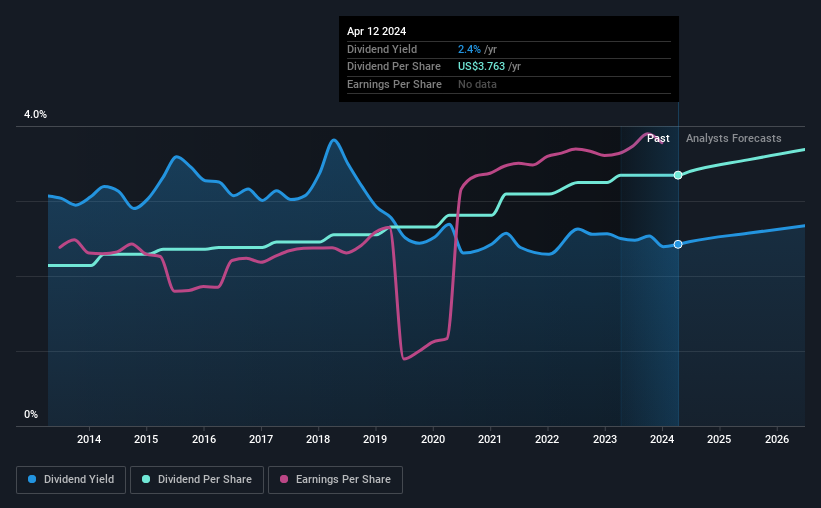The Procter & Gamble Company (NYSE:PG) Will Pay A US$1.0065 Dividend In Four Days
Readers hoping to buy The Procter & Gamble Company (NYSE:PG) for its dividend will need to make their move shortly, as the stock is about to trade ex-dividend. Typically, the ex-dividend date is one business day before the record date which is the date on which a company determines the shareholders eligible to receive a dividend. The ex-dividend date is important because any transaction on a stock needs to have been settled before the record date in order to be eligible for a dividend. Thus, you can purchase Procter & Gamble's shares before the 18th of April in order to receive the dividend, which the company will pay on the 15th of May.
The company's upcoming dividend is US$1.0065 a share, following on from the last 12 months, when the company distributed a total of US$3.76 per share to shareholders. Based on the last year's worth of payments, Procter & Gamble has a trailing yield of 2.4% on the current stock price of US$155.33. We love seeing companies pay a dividend, but it's also important to be sure that laying the golden eggs isn't going to kill our golden goose! As a result, readers should always check whether Procter & Gamble has been able to grow its dividends, or if the dividend might be cut.
See our latest analysis for Procter & Gamble
Dividends are typically paid out of company income, so if a company pays out more than it earned, its dividend is usually at a higher risk of being cut. Procter & Gamble is paying out an acceptable 61% of its profit, a common payout level among most companies. Yet cash flows are even more important than profits for assessing a dividend, so we need to see if the company generated enough cash to pay its distribution. It paid out more than half (57%) of its free cash flow in the past year, which is within an average range for most companies.
It's encouraging to see that the dividend is covered by both profit and cash flow. This generally suggests the dividend is sustainable, as long as earnings don't drop precipitously.
Click here to see the company's payout ratio, plus analyst estimates of its future dividends.
Have Earnings And Dividends Been Growing?
Stocks in companies that generate sustainable earnings growth often make the best dividend prospects, as it is easier to lift the dividend when earnings are rising. If business enters a downturn and the dividend is cut, the company could see its value fall precipitously. Fortunately for readers, Procter & Gamble's earnings per share have been growing at 10% a year for the past five years. Procter & Gamble has an average payout ratio which suggests a balance between growing earnings and rewarding shareholders. Given the quick rate of earnings per share growth and current level of payout, there may be a chance of further dividend increases in the future.
The main way most investors will assess a company's dividend prospects is by checking the historical rate of dividend growth. Since the start of our data, 10 years ago, Procter & Gamble has lifted its dividend by approximately 4.6% a year on average. It's good to see both earnings and the dividend have improved - although the former has been rising much quicker than the latter, possibly due to the company reinvesting more of its profits in growth.
The Bottom Line
From a dividend perspective, should investors buy or avoid Procter & Gamble? It's good to see earnings are growing, since all of the best dividend stocks grow their earnings meaningfully over the long run. That's why we're glad to see Procter & Gamble's earnings per share growing, although as we saw, the company is paying out more than half of its earnings and cashflow - 61% and 57% respectively. In summary, it's hard to get excited about Procter & Gamble from a dividend perspective.
So while Procter & Gamble looks good from a dividend perspective, it's always worthwhile being up to date with the risks involved in this stock. Case in point: We've spotted 2 warning signs for Procter & Gamble you should be aware of.
A common investing mistake is buying the first interesting stock you see. Here you can find a full list of high-yield dividend stocks.
Have feedback on this article? Concerned about the content? Get in touch with us directly. Alternatively, email editorial-team (at) simplywallst.com.
This article by Simply Wall St is general in nature. We provide commentary based on historical data and analyst forecasts only using an unbiased methodology and our articles are not intended to be financial advice. It does not constitute a recommendation to buy or sell any stock, and does not take account of your objectives, or your financial situation. We aim to bring you long-term focused analysis driven by fundamental data. Note that our analysis may not factor in the latest price-sensitive company announcements or qualitative material. Simply Wall St has no position in any stocks mentioned.

